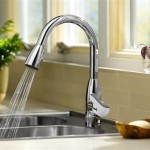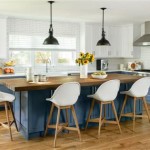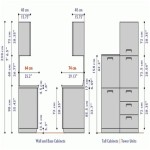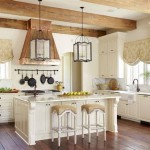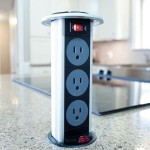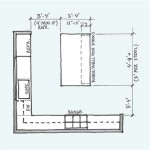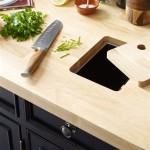Breakfast Bars For Small Kitchens: Maximizing Space and Functionality
In compact living spaces, kitchens often face the challenge of limited square footage. This necessitates creative design solutions to optimize functionality and aesthetics. Breakfast bars emerge as a practical and versatile addition to small kitchens, offering a dedicated space for dining, food preparation, and even casual social interaction. This article will explore various breakfast bar designs suitable for small kitchens, considering factors such as space constraints, material choices, and overall layout integration.
Understanding the Advantages of a Breakfast Bar
A breakfast bar in a small kitchen presents several noteworthy benefits. Firstly, it provides a designated eating area, eliminating the need for a separate dining table that would consume precious space. This is particularly advantageous in studio apartments or smaller homes where every inch matters. Secondly, a breakfast bar can double as a food preparation surface, expanding the available countertop space. This is especially useful when cooking or baking, allowing for more efficient workflow. Thirdly, breakfast bars can serve as a social hub, facilitating conversation and interaction while meals are being prepared. This enhances the overall ambiance of the kitchen and makes it a more inviting space.
Furthermore, strategically placed breakfast bars can visually delineate the kitchen area from other living spaces in open-concept layouts. This creates a sense of definition and organization, contributing to a more aesthetically pleasing environment. Finally, the storage potential beneath a breakfast bar should not be overlooked. Cabinets, drawers, or open shelving can be incorporated to store kitchen essentials, further maximizing the utility of the limited space.
Types of Breakfast Bar Designs for Small Kitchens
The suitability of a particular breakfast bar design depends heavily on the kitchen's layout and available space. Several designs are particularly well-suited for small kitchens:
1. Peninsula Breakfast Bar: A peninsula breakfast bar extends outwards from an existing countertop or wall, creating a semi-enclosed space. This design is ideal for kitchens that have an open side or are adjacent to another room. The peninsula provides ample seating and countertop space while remaining connected to the main kitchen area. It can also serve as a divider between the kitchen and living room.
2. Island Breakfast Bar: A kitchen island with an integrated breakfast bar is a popular choice for larger small kitchens where space permits. This design offers a central workspace with seating on one or more sides. Islands can be equipped with sinks, cooktops, or storage compartments, further enhancing their functionality. A smaller island can be custom-built to fit the specific dimensions of the kitchen, ensuring optimal use of space.
3. Wall-Mounted Fold-Down Breakfast Bar: For extremely small kitchens where space is at a premium, a wall-mounted fold-down breakfast bar offers a space-saving solution. When not in use, the bar folds flat against the wall, freeing up valuable floor space. When needed, it can be easily unfolded to provide a small dining or work surface. This design is particularly suitable for studio apartments or small galley kitchens.
4. Countertop Extension Breakfast Bar: This involves extending the existing countertop to create an overhang that serves as a breakfast bar. This is a simple and cost-effective option that requires minimal construction. The overhang provides space for seating, and stools can be tucked away when not in use. This design integrates seamlessly with the existing kitchen layout and maximizes the use of available countertop space.
5. Floating Breakfast Bar: Similar to a wall-mounted design, a floating breakfast bar is attached to the wall without any visible support legs. This creates a clean and modern aesthetic while maximizing floor space. Floating breakfast bars typically have a minimalist design and are ideal for contemporary kitchens.
Key Considerations for Choosing Materials and Finishes
The choice of materials and finishes for a breakfast bar significantly impacts its durability, aesthetics, and overall functionality. Selecting appropriate materials is crucial in a small kitchen setting where space efficiency and visual appeal are paramount.
1. Countertop Materials: The countertop material should be durable, easy to clean, and aesthetically pleasing. Popular choices include:
a. Granite: Granite is a natural stone that offers excellent durability and heat resistance. It is available in a wide range of colors and patterns, making it a versatile choice for any kitchen style. However, granite requires regular sealing to prevent staining.
b. Quartz: Quartz is an engineered stone that is highly durable, stain-resistant, and low-maintenance. It offers a consistent color and pattern, making it a predictable choice for designers. Quartz is a popular alternative to granite.
c. Wood: Wood countertops add warmth and character to a kitchen. Butcher block countertops are a particularly popular choice for breakfast bars, as they provide a durable and functional surface. Wood countertops require regular oiling to maintain their appearance and prevent warping.
d. Laminate: Laminate is a cost-effective option that is available in a wide range of colors and patterns. It is easy to clean and maintain, but it is not as durable as granite or quartz.
2. Base Materials: The base of the breakfast bar can be constructed from various materials, depending on the design and desired aesthetic. Options include:
a. Wood Cabinets: Wood cabinets provide ample storage space and can be customized to match the existing kitchen cabinetry. They offer a traditional and sophisticated look.
b. Metal Frames: Metal frames provide a modern and industrial look. They are durable and easy to maintain. Metal frames can be paired with various countertop materials to create a unique breakfast bar.
c. Open Shelving: Open shelving provides a minimalist and airy look. It is ideal for displaying decorative items or storing frequently used items. Open shelving requires regular cleaning to maintain its appearance.
3. Finishes: The finish of the breakfast bar should complement the overall kitchen design. Consider factors such as color, texture, and sheen. Popular finishes include:
a. Painted Finishes: Painted finishes offer a wide range of color options and can be customized to match any kitchen style. They are relatively easy to clean and maintain.
b. Stained Finishes: Stained finishes highlight the natural grain of the wood and add warmth to the kitchen. They are available in a variety of shades, from light to dark.
c. Natural Finishes: Natural finishes showcase the raw beauty of the material. They are often used for wood countertops and add a rustic touch to the kitchen.
Optimizing Space and Functionality in Small Kitchens
Several strategies can be employed to optimize space and functionality when incorporating a breakfast bar into a small kitchen:
1. Multi-Functional Furniture: Choose stools or chairs that can be easily nested or folded away when not in use. Consider stools with built-in storage compartments for added functionality.
2. Integrated Storage Solutions: Maximize storage space beneath the breakfast bar by incorporating cabinets, drawers, or open shelving. Utilize vertical space by installing shelves above the breakfast bar.
3. Lighting: Proper lighting is essential for creating a functional and inviting breakfast bar area. Install pendant lights or spotlights above the bar to provide adequate illumination for food preparation and dining.
4. Color Palette: Use a light and airy color palette to create a sense of spaciousness. Neutral colors such as white, cream, and gray can help to make a small kitchen feel larger.
5. Layout Considerations: Carefully plan the layout of the breakfast bar to ensure that it does not obstruct traffic flow or impede access to other areas of the kitchen. Consider the placement of appliances and fixtures to optimize the overall functionality of the space.
6. Scale and Proportion: Ensure that the breakfast bar is appropriately scaled to the size of the kitchen. Avoid oversized or bulky designs that can overwhelm the space. Choose a design that is proportionate to the surrounding elements.
By carefully considering these factors, it is possible to create a functional and aesthetically pleasing breakfast bar that maximizes space and enhances the overall enjoyment of the small kitchen.

Breakfast Bar Ideas For Small Kitchens The Used Kitchen Company

82 Small Yet Stylish Breakfast Bar Ideas Shelterness

Breakfast Bar Ideas For Small Kitchens Transform Your Space Project Reclaim

How To Organize A Breakfast Bar 25 Functional Ideas Digsdigs

A Breakfast Bar Can Improve Life In The Kitchen

Breakfast Bar Ideas For Small Kitchens The Used Kitchen Company

Small Kitchen With Breakfast Bar Transitional

Lamerge Bar Dining Table Set For 2 3 Piece And Chairs Kitchen Counter Height Small With Storage

26 Ideas For Slotting In A Small Breakfast Bar Houzz Ie

Maximise A Small Kitchen With Wall Mounted Breakfast Bar Porcelanosa
See Also

